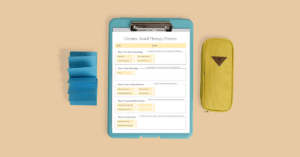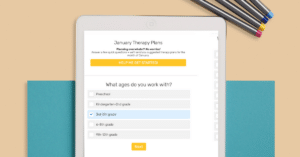Listen on Apple Podcasts Listen on Spotify
In this week’s episode of the SLP Now podcast, we’re going to continue with our 6-part series all about how to rock your school year and talk about setting up your caseload. 💪
I’ll be honest with you here. I’ve tried so many different data collection systems that I’ve lost track — I spent a lot of time searching for a “perfect” solution, but (spoiler alert!) I don’t think there is one right solution for all SLPs.
There are, however, a lot of really great options for data collection out there. So, what we have is the opportunity to get creative and put together a caseload system that complements our unique strengths and quirks. 🙌
That’s the angle we’re taking on today’s episode, so grab your beverage of choice (I’ll have a chai latte!), put your feet up, and listen in.
Key Takeaways
– Things to consider as you set up your data collection systems
– Creating systems based on your strengths
– State and district requirements
– The value of data checklists
– Different styles of data sheets (so you can choose which is right for you)
– A simple hack for goal tracking
– Using a paper planner
– Digital solutions to track progress
Links Mentioned in the Podcast
– Data sheets that you can download that for free from TpT
– The data sheets that I used to use (but would always struggle to update)
– Quiz: What’s your ideal data collection system?
– Natalie Snyders’ weekly data sheet
– SLP Now student progress graphs
Subscribe & Review in iTunes
Are you subscribed to the podcast in iTunes? If not, please subscribe today to get the latest episodes sent directly to you. 💪
Click here to subscribe — and bonus points if you leave us a review!
Reviews help other SLPs find the podcast (and I love reading your feedback).
Just click here to review, select “Ratings and Reviews,” and “Write a Review” → Let me know what your favorite part of the podcast is.
Thanks so much!
Transcript
And it's done. So that's the process. Let's dive into more of the logistics about how to set up your case load, because we have that basic student information, we have our schedule now, we have things that... like a good starting point and the next big hurdle is figuring out data collection and therapy and all of that. So this will set us up for success with those components. I have tried so many different data collections systems I have lost track, but I was really searching for like the perfect solution and I don't think that there's one perfect solution for all SLPs. I think it really depends on the dynamics of our caseload. It depends on our personal preference and just... I don't know. From year to year it might change for any individual SLP as they move through different settings and all of that. But these are some questions that I think are helpful, because like I said, I've tried a lot of systems and gone through a lot of changes, I've talked to a lot of SLPs trying to figure out the best data system for them.
Some things to consider are what are you most comfortable with? Do you hate technology? Can you... Like do you not like using a computer? Then if that's the case, you probably don't want to use spreadsheets for your data or if you really struggle with mixed groups or if you are always behind with Medicaid billing or if your district requires you to create graphs, think about solutions that will... Because data collection is so closely tied to what you do in a mixed group, it's so closely tied to billing Medicaid, because we need that data to do the billing. It's so closely tied to tracking progress and to creating those graphs. So think about the things that you need that you struggle with most that you would like to make easier for yourself and try and come up with a system or look for a system, I'll give you lots of ideas here, that meets those needs.
We definitely want to consider our state and district requirements. I know some districts or states require you to graph progress and so if that's a thing that you have to do, you might want to try and find a solution that makes that easier so you're not always pulling your hair out when you're doing that. We want to think about a system that will flow with us throughout the entire year, because we always have to update goals and we want it to be easy enough to set up an update so that we're not... so we don't get behind, so we can actually stick to our system. Because I know... I use these, I'll show you the data sheets that I used to use, but I would always struggle to update them after the IEP meeting.
So one solution could be to update them right after the IEP and just have that be part of the IEP checklist, or maybe the hassle of finding the student's digital file for this data sheet, then updating it, retyping the goals, like maybe that's not a good idea. Maybe I just need a blank template and I need to write in the goals or whatever it may be. Maybe I need to keep my goals on a separate sheet of paper and not put them on the data sheet. Whatever works best for you, consider that. There's not one right answer for everyone.
I did make a little quiz if you guys want to check this out and it helps navigate through some of those questions and give suggestions based on those answers, so that quiz will also be on the page for this course. But then let's just dive into some examples.
So like we talked about already, there is a lot of different options that we can use. There are five million different data sheets that we could use, but we're going to talk about some different styles of data sheets and maybe one of those will be a good fit for you. Maybe a planner is a good fit for you or maybe it's a digital kind of solution.
So we'll just talk about some different options here. Data sheets, like this data sheet on the left, is what I used for a very long time. It's a free editable data sheet so you can like move things around if you don't like one of the columns or if you just want to add in your student's information, you can view that. You can download that for free from Teachers Pay Teachers, and how it works is I just put in like the important caseload information and then I list the student's goals, and one hack for me was that I numbered the goals and then when I was taking data, I could just write the number of the goal and I wouldn't have to write out the whole thing, which sounds like a little thing but if you're working with a mixed group and you have like four students you're taking data on, those couple seconds for each student are very valuable.
So instead of writing answer what questions, I would just say goal one and I just wrote who because we were focusing on the who questions in this example. But then I use the little boxes to keep track of the accuracy and then I could also use that to make any notes, I use that for planning purposes sometimes and that worked well enough. It's a little bit tricky to maintain, so I always had just blank data sheets that I was filling in with updated goals. But if I hadn't had a good system to update... because they were in a PowerPoint so you can easily just duplicate the slides and update the goals and reprint it real quick. So that's totally doable. And that's if you want just one student on one sheet of paper.
Another option, this is from Natalie Snyders, and she puts her whole caseload, well not her whole case load, but a full day of students on one sheet. Like you can see, she sees Joe from 8:10 to 8:30 and she makes a note of which classroom they're in so it's easy for her to find them, which is helpful. That's smart. Then she has shorthand for all of their goals and then she just circles the goal that they're working on and then she takes data in those boxes. So it doesn't give her a ton of room, but it's nice because it can be helpful for planning your day of sessions. Like you could jot down notes in the boxes with the students' names, like we're going to do this today, and so you could use that for planning and data in one sheet. That's a pretty nice option there.
Then the only thing is that like it makes it nice for Medicaid billing if you bill on a daily basis because then you can just go through and look at the notes and then enter that and then be done, so that's one other pro for that one. But then it does make it harder to see how students are progressing over time. You'd have to flip through a bunch of different data sheets and find a way to organize that effectively because you... like you might see Joe on Monday and Tuesday and so you'd have to figure out like where all those data sheets are, where all his spots are, so that makes it a little bit tricky. But there's lots of pros for that one. Then it's great for mixed groups because it's all on one sheet. Then kind of the reverse apply to the single student data sheet.
So just consider all of those components before you pick a system and just figure out what is most important to you. We likely won't find one thing that addresses everything that we could possibly need, but hopefully we get pretty close.
Another option that I don't necessarily recommend, but it would be like a similar version of what Natalie was doing, but just in a planner. So they have teacher planners out there. The biggest problem with this is you get the benefits of the planner... or the data sheet that Natalie uses. You can easily flip between pages. It's all in one nice little bound thing and then you know, okay I see Johnny in this spot, he's always going to be in this spot and you can just like flip to the last couple of pages so that's nice, but it would involve a lot of work to fill that in every time. At least with Natalie's system, you can just print a couple copies of that and have that ready to go.
But with the paper planner you would have to write in a bunch of those different components. Maybe you want to make your own planner like this that has all of those boxes, that's an option. But when I did a poll in the Facebook group, a couple of people mentioned this, so I thought I would share it, and it is very pretty. That would be fun to use.
Okay. And then another option is digital data. This allows you to set up your schedule and so you just set up all of your students like you can see in this little calendar and then you can plan your sessions and attach them there. So that helps with not having to flip through a bunch of different pages and you can just quickly access that and enter your data there.
A lot of digital data collection solutions help save time with documentation and billing, like this one has a templated summary. So if I enter... Sorry, I think the GIF is cutting off a little quickly, but if I enter data for the session and then I click load template, it makes a Medicaid friendly template that pulls in my student's name, what we did in the session, their data. So I can just type in the accuracy, like 80% that's how we did and then load that template and then at the end of the day I can just click through and enter those components, so that is a nice benefit for that. It also makes it easy to review student progress.
A lot of these digital systems will graph your data for you, so with SLP Now you can see the student's progress within the session and each one is set up a little bit differently. So all of them have the graph within the session, but a lot of, pretty much all, digital solutions will have a way for you to view student progress on a graph, which if your district requires that, that might be a nice nudge in that direction.
But like I said, there's not a perfect solution for every SLP. Like, I can't say everyone needs to do this. It really depends on what your needs are, and I hope that quick helps you narrow it down if you're feeling overwhelmed with all of the different options.
Sign up to receive email updates
Enter your name and email address below and I'll send you periodic updates about the podcast.




Reader Interactions